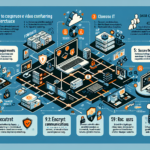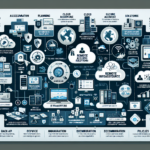Configuring IT infrastructure for video conferencing systems requires careful planning to ensure high performance, scalability, reliability, and security. Below is a detailed guide tailored for IT managers responsible for datacenters, storage, servers, and virtualization:
1. Assess Video Conferencing Requirements
- User Count: Determine the expected number of users (internal and external).
- Concurrent Meetings: Estimate the number of simultaneous video conferences.
- Bandwidth Needs: Calculate the bandwidth requirements for video, audio, and screen-sharing traffic.
- Supported Platforms: Check compatibility with Windows, Linux, mobile devices, and browsers.
- Integrations: Determine if the system requires integration with other tools (e.g., Microsoft Teams, Zoom, Slack, or CRM systems).
2. Network Infrastructure
- High-Speed Internet Connection: Ensure sufficient bandwidth to handle video traffic. Upgrading to fiber-optic or dedicated leased lines may be necessary.
- QoS (Quality of Service): Configure routers and switches to prioritize video conferencing traffic.
- Firewall Rules: Open necessary ports for the video conferencing system (typically TCP/UDP for signaling and media).
- VPN Access: Ensure secure remote access for users outside the corporate network.
- Wi-Fi Optimization: Deploy high-performance Wi-Fi access points in meeting rooms and offices.
3. Server Infrastructure
- Dedicated Servers: Set up dedicated servers for hosting video conferencing software if you’re using an on-prem solution.
- CPU: Multi-core processors for handling real-time video encoding/decoding.
- RAM: Sufficient memory to handle concurrent video streams.
- Storage: SSDs for fast access to recordings and logs.
- GPU Acceleration: Consider NVIDIA or AMD GPUs for hardware-accelerated video processing.
- Virtualized Infrastructure: Use VMware, Hyper-V, or Proxmox for flexible resource allocation and scalability.
- Cloud Integration: Consider hybrid or fully cloud-based video conferencing platforms like Zoom or Microsoft Teams for scalability and reliability.
4. Storage Setup
- Recording and Archive Storage: Provide sufficient storage for video recordings, shared files, and logs.
- Centralized NAS/SAN: Use a Network Attached Storage (NAS) or Storage Area Network (SAN) with RAID configurations for redundancy.
- Backup: Implement backup solutions to protect recordings and user data.
- Retention Policies: Define storage retention policies to automatically clean up old or unused recordings.
5. Backup and Disaster Recovery
- Backup Configuration: Ensure backups of all servers hosting video conferencing services are performed regularly.
- Disaster Recovery Plan: Have a failover system in place using secondary servers or cloud services to ensure continuity during outages.
6. Virtualization and Kubernetes
- Virtual Machines: Deploy video conferencing software on VMs for scalability and isolation.
- Containerization: Use Kubernetes to deploy scalable and containerized video conferencing applications.
- Kubernetes can handle load balancing, scaling, and failover effectively.
- Use tools like Helm for deploying video conferencing software as Kubernetes charts.
- Resource Allocation: Ensure proper allocation of CPU, RAM, and GPU resources for video processing workloads.
7. AI Integration
- AI Features: Enable features like automatic transcription, background noise cancellation, facial recognition, and sentiment analysis.
- AI Workloads: Deploy AI models on dedicated GPU servers for real-time processing.
- Tool Integration: Use services like NVIDIA AI SDKs or TensorFlow models for enhancing video conferencing experiences.
8. Security Measures
- Encryption: Enable end-to-end encryption (E2EE) for all video calls.
- Access Control: Use LDAP, Active Directory, or OAuth for user authentication and role-based access control.
- Patch Management: Regularly update software to address vulnerabilities.
- Endpoint Security: Ensure all devices accessing the system have antivirus and endpoint protection.
9. Monitoring and Performance Management
- Bandwidth Monitoring: Use tools like PRTG or SolarWinds to monitor network usage.
- Server Monitoring: Monitor CPU, RAM, storage, and GPU utilization using tools like Nagios or Zabbix.
- User Experience: Collect feedback from users to identify and resolve performance bottlenecks.
10. Scalability and Future Planning
- Cloud Integration: Use cloud-based services for seamless scaling as your organization grows.
- Hybrid Models: Combine on-premises and cloud solutions for flexibility.
- Upgrades: Plan for hardware upgrades (e.g., newer GPUs, faster storage) as video conferencing demands increase.
Recommended Hardware and Software
Hardware
- Servers: Dell PowerEdge, HPE ProLiant, or Supermicro with multi-core CPUs and GPUs.
- Storage: Synology, NetApp, or Dell EMC.
- Network Devices: Cisco or Juniper routers and switches.
- GPUs: NVIDIA A100, RTX 4000, or AMD Instinct for video acceleration.
Software
- Video Conferencing Platforms: Zoom, Microsoft Teams, Cisco Webex, or Google Meet.
- Virtualization: VMware vSphere, Hyper-V, or Proxmox.
- Containerization: Kubernetes with Helm charts.
- Monitoring Tools: PRTG, Zabbix, SolarWinds.
By implementing the above steps, you can create an optimized IT infrastructure that ensures smooth, secure, and scalable video conferencing for your organization.
How do I configure IT infrastructure for video conferencing systems?





